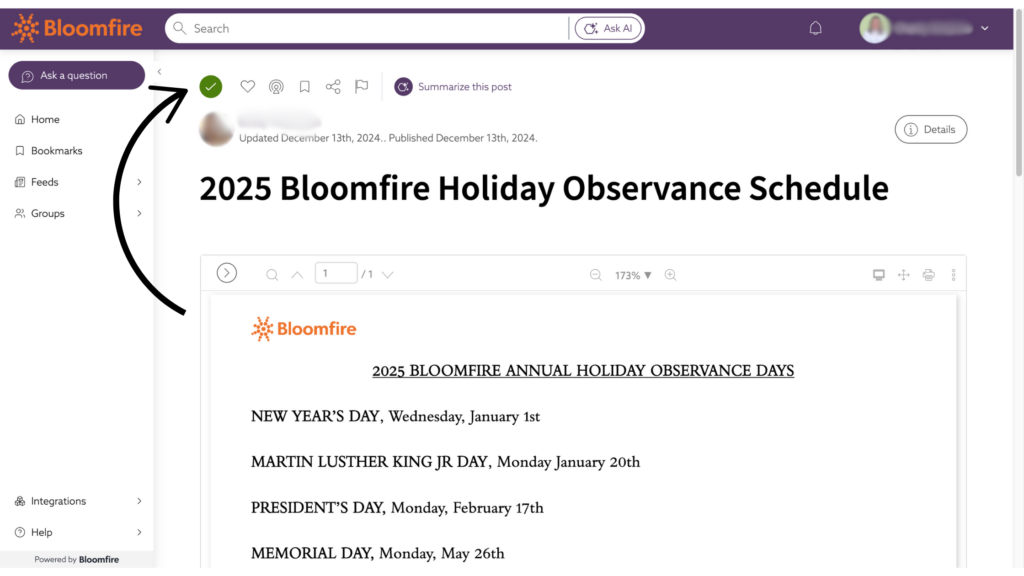Why Data Decay Puts Your AI Strategy at Risk

In our years of designing advanced knowledge management (KM) capabilities in Bloomfire, it was inevitable to encounter the most significant barriers to maximizing the value of artificial intelligence (AI) in KM. Data decay, for instance, is one of the silent threats to the effectiveness of AI strategies.
Data is the lifeblood of AI. Without high-quality data, AI systems cannot learn, adapt, or make accurate predictions. As decay diminishes data quality, its consequences can compromise not just AI initiatives but various business aspects. In this article, we will discuss the impact of data degradation on AI, common examples, and how to mitigate its risks.
What Is Data Decay
Data decay, also known as data degradation or data rot, refers to the gradual decline in the quality and reliability of data over time. As data ages, it becomes less accurate, relevant, and valuable for decision-making and even future AI applications. This phenomenon occurs due to various factors, such as:
- Outdated data oversight
- Changes in the data source
- Changes in real-world information (e.g., market shifts and changing customer behaviors)
- Organizational shifts (e.g., restructuring that affects job titles or roles and evolving business rules)
- Technological advancements (e.g., legacy system incompatibility due to new data formats)
A key element that adds fuel to the surety of data decay is inattention. Neglected data loses its vibrancy and usefulness, ultimately hindering the effectiveness of any system that relies on it. Poor data quality, as pointed out by Gartner, can lead to organizations losing about $12.9 million annually. This is a fact that remained unchanged in the past years.
Why It’s Important to Pay Attention to Data Decay
Data decay poses a significant challenge to the effectiveness and reliability of AI systems, potentially tainting business efficiency. According to Gartner, the decay rate in business-to-business (B2B) contact data alone is roughly 70% annually. B2B data rot often delays or jeopardizes sales and marketing tactics. However, in knowledge management, the consequences of data degradation can target AI’s core functionality and performance.
Researchers emphasized the need to eliminate data decay, which can manifest as data imbalance, heterogeneity, scarcity, and other quality issues. The study underscores that outdated or incomplete data hampers the accuracy and effectiveness of machine learning (ML) models, one of the technologies used to build AI systems.
With these direct outcomes in mind, data rot creates a ripple effect that leads to the following disadvantages that put your AI strategy at risk:
1. Reduces AI Performance
Outdated or inaccurate data within an AI-powered knowledge management system introduces significant detrimental effects. It compromises the fidelity of AI models, resulting in unreliable predictions, flawed insights, and degraded system performance. This consequence derails AI-driven decisions, leading to subpar actions and missed opportunities.
2. Increases Bias
Data decay can amplify existing biases present in the original dataset. As data ages and becomes less representative of current realities, it can solidify and even magnify societal prejudices embedded in the original information.
For example, a large financial institution using an AI-powered KM system to assess loan applications has outdated training data. This reflects historical biases against certain demographics. The AI model might unfairly deny loans to qualified applicants from those groups, perpetuating discriminatory lending practices.
This outcome exemplifies how data decay can exacerbate these prejudices, leading to AI-driven decisions that unfairly disadvantage specific populations. Additionally, it underscores how data should be simultaneously updated when business rules change.
3. Reduces AI Efficiency
As data quality degrades, models trained on this decaying data require more frequent retraining. They also need recalibration to maintain acceptable levels of accuracy and effectiveness. This increased demand for model maintenance translates to a significant rise in computational resources, engineering time, and overall operational costs.
Consequently, data rot can impede the efficiency of AI initiatives. As a result, it diminishes their return on investment (ROI) and obstructs the realization of their full potential.
4. Erodes User Trust
The reliability of AI systems is intrinsically linked to the quality of the data they process. When data decay compromises the accuracy and objectivity of AI outputs, user trust and confidence in these systems erode.
This erosion of trust can manifest as organizational resistance to AI adoption, blocking the seamless integration of AI solutions into critical workflows and decision-making processes. In turn, organizations may fail to fully leverage the transformative potential of AI. Ultimately, they miss out on efficiency gains and competitive advantage.
5. Impedes Innovation
Outdated information stifles innovation by limiting access to current trends, best practices, and emerging knowledge. This could lead to stagnant decision-making, delaying strategic planning, and impeding the development of innovative solutions.
For instance, a marketing team relying on outdated market research in their knowledge management system might miss the growing trend of short-form video content. This prompts them to invest in costly television campaigns that yield minimal returns. Their marketing strategy falls flat, failing to engage the target audience and stunting the company’s ability to compete effectively in the evolving digital landscape.
Examples of Data Decay
The data decay phenomenon can be a collective event that reveals itself in many forms. A key step to managing this degradation is recognizing its presence in your knowledge management platform before your AI system can use it. Here are some of the common examples of data degradation in terms of type:
- Outdated content: Once accurate information may become obsolete due to evolving industry trends (e.g., KM trends), new regulations, or the passage of time. For instance, old product documentation or outdated training materials can mislead employees and customers.
- Broken links and references: As files are moved, renamed, or deleted, links within documents and knowledge bases can break, leading to frustrating dead ends for users seeking information.
- Redundant information: Duplicate files or entries create clutter and confusion, making it difficult for users to locate the most relevant and up-to-date version of a document. This redundancy can also lead to inconsistencies and errors.
- Inconsistent formatting: Variations in data formatting across different sources can hinder effective search and analysis. This inconsistency may include differences in date formats, naming conventions, or data structures.
- Incomplete data: Missing data fields or records can limit the usefulness of the information and impede effective decision-making. For example, incomplete customer profiles can hinder personalized marketing efforts.
Did You Know? Bloomfire’s AI-powered knowledge management system actively combats data decay by promoting continuous content updates and facilitating knowledge sharing within the organization. Its features encourage users to contribute, validate, and refresh information, ensuring the knowledge base remains current and relevant, thus mitigating the risks associated with outdated or inaccurate data.
How To Combat Data Decay in Your AI Knowledge Base
The cost of data decay covers multiple areas of company operations that compromise productivity, promote duplicate work, and delay valuable business strategies. If translated into actual figures, this could go over millions of dollars every year. However, with the apparent damaging effects of data rot, only less than half of the organizations surveyed by McKinsey in 2023 were actively mitigating the risk of inaccurate data in their AI applications.
Whether this is due to unrealized harm or a lack of awareness that data rot manifests in various forms, organizations must adopt practices to combat data decay. To ensure your knowledge management system’s AI features produce fresh, accurate, and reliable content, consider the following steps.
- Invest in unstructured data management tools to keep data clean: Unstructured data management tools employ data cleaning techniques. These include natural language processing (NLP) and machine learning to automatically categorize, tag, and cleanse data within a knowledge base.
- Build a collaborative knowledge base: Establishing a collaborative knowledge base allows for continuous updates and validation of information from diverse perspectives. Implement features that enable users to easily add, edit, and validate information. In turn, this fosters a dynamic and evolving knowledge repository that combats data decay.
- Establish clear data ownership: Designate individuals or teams as data stewards who oversee data quality, implement validation procedures, and ensure adherence to data governance policies. This ensures timely updates of specific datasets within the AI knowledge base.
- Cultivate a learning and sharing culture that embraces feedback: A learning and sharing culture is a continuous loop of knowledge refinement and validation within the AI knowledge base. Encourage your employees to actively provide feedback on the accuracy, relevance, and completeness of information. This will allow for identifying and correcting outdated or erroneous data, ensuring the AI system remains up-to-date and reliable.
- Provide learning and development centers: In relation to building a collaborative learning environment at the workplace, provide and act as hubs for employees to access the latest information, best practices, and training materials. Doing so ensures the knowledge base remains current and relevant.
- Make mentoring a part of the culture: Experienced employees can share their expertise with newer members, facilitating updating the knowledge base with fresh perspectives and insights, thus mitigating the effects of data decay.
- Recognize and reward contribution: Incentivize users to actively update and maintain the knowledge base, ensuring data remains current and relevant. You can leverage gamification features like points, badges, and leaderboards or through formal recognition programs that highlight valuable contributions.
- Perform periodic knowledge audits: A comprehensive review of the knowledge base content, comparing it against current standards, best practices, and real-world information, can identify and remove outdated, irrelevant, or inaccurate information.
- Indicate content freshness: While visual cueing users about the recency and relevance of information might seem simple, it can significantly help prevent data decay. Bloomfire does this by displaying a green checkmark alongside recently updated or verified content by subject matter experts. These elements signal to users that the information is current and reliable.

An example of how the green mark indicates content freshness.
Managing data decay is not a one-time task but an ongoing commitment to maintaining the health and integrity of your AI knowledge base. Through proactive monitoring, diligent data hygiene practices, and a robust data governance framework, you can ensure your AI systems remain fueled with accurate, relevant, and trustworthy information.
Protect Your AI Strategy From Data Decay
Data decay presents a formidable challenge to any organization seeking to leverage the transformative power of AI. Fortunately, proactive measures like continuous data monitoring, regular data refreshes, and robust data governance can help combat data rot. In turn, they ensure that AI initiatives thrive on a foundation of trustworthy and relevant information.
Is Your Data AI-Ready?
Simplify your data’s AI readiness with tools that ensure precision and accuracy.
Learn More

How to Improve Customer Service in Call Centers: 21 Ways to Enhance Contact Center Experience

Innovative Ways Companies Are Using Knowledge Management

How to Implement a Knowledge Check in 6 Steps

Estimate the Value of Your Knowledge Assets
Use this calculator to see how enterprise intelligence can impact your bottom line. Choose areas of focus, and see tailored calculations that will give you a tangible ROI.

Take a self guided Tour
See Bloomfire in action across several potential configurations. Imagine the potential of your team when they stop searching and start finding critical knowledge.